Today we’ll talk about how to bathe a puppy and how to get your puppy used to baths! It’s easy enough once you’ve figured out where and when to bathe him, which products to use and what to pay attention to.
Of course the main objective is to clean your little guy from the poop or mud he rolled around in *GROSS*, but it’s also a great bonding opportunity!
Puppy bath time is also an integral part of your puppy’s socialization process and will contribute to turning him into a confident, happy adult dog who’s not afraid of bath time or having his paws and ears handled by a vet.
How to get your puppy used to baths early on
It’s important to get your puppy used to a bathing and grooming routine early on. Consider it part of your puppy’s socialization program. You’ll want him to become comfortable with the following:
- Nail trims
- Cleaning ears
- Wiping paws
- Brushing
- Electric clippers/trimmers for long haired dogs
- Blow dryer
- Brushing their teeth
I’m Barbara and I write regularly for That Mutt. I’m also a blogger over at K9s Over Coffee. This post contains affiliate links.
Puppy’s first bath – how to bathe a puppy
So first, you’ll have to figure out a few logistics. For instance, where are you going to bathe your puppy, what products will you use, and when is the best time of day for a puppy’s bath? (Pick a time when your puppy is tired. Haha.)
Where to bathe your puppy
The beauty about puppies is they’re relatively small for their first 3 months, regardless of breed. Of course large and extra large breed puppies like great Danes will grow much quicker than others. But in general you’ll be able to give your puppy a bath in your own home at least for their first few months.
Where, exactly, is up to your personal preference and what’s available in your home.
Bathe your puppy in the sink
You mighty be able to bathe your puppy your kitchen, laundry room or bathroom sink.
Madison, the Yorkipoo pictured below, used to be one of my dog walking clients. I snapped this picture of her in the laundry room sink. I had to give her an impromptu bath after we were surprised by a downpour on a walk. Her owner bathed her in that sink ever since she was a tiny puppy, and it’s still the perfect size for Madison!
Even now that she’s fully grown, she only weighs 8 pounds! That’s how much my boxer mix Missy weighed when she was 8 weeks old, ha!
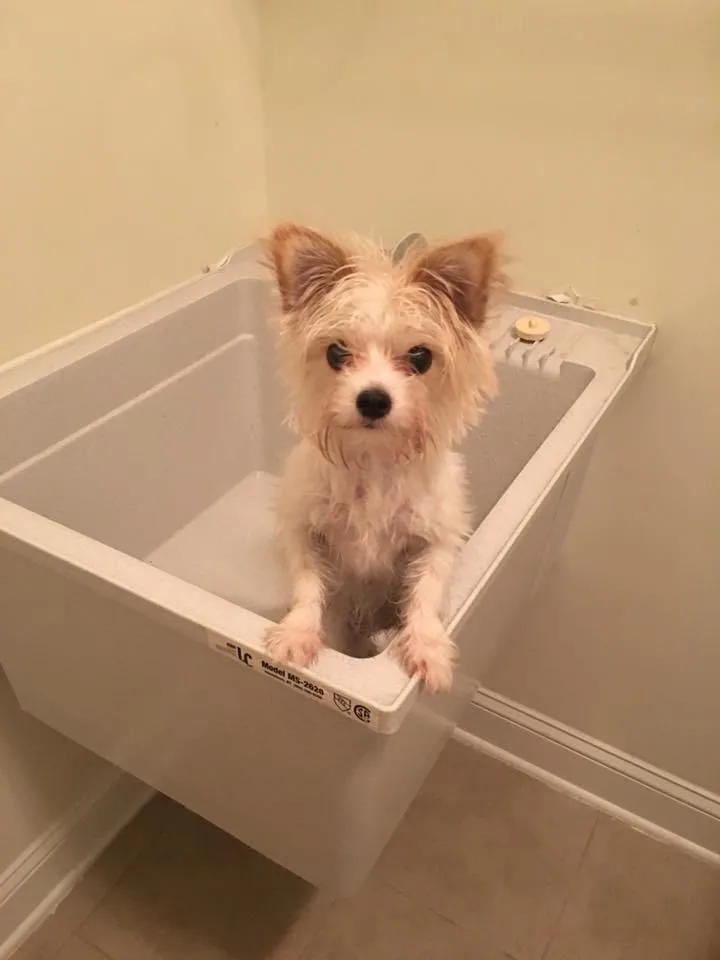
Bathe your puppy in the tub
Of course you can also give your puppy a bath in an actual bathtub if you have one. That’s where my former pups Missy and Buzz, two Boxer mixes, got their first baths. Myself or my ex-husband, would sit in the tub with them to make the experience a fun one.
That said, you’ll want to wear appropriate bath time clothes because I guarantee that you’ll end up taking at least a partial bath as well! Even if you’re bathing your puppy in a sink. I would wear an old t-shirt or tank top along with swim suit bottoms or workout shorts.
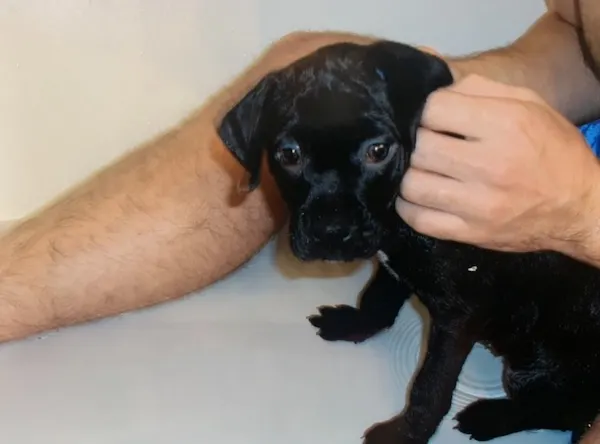
I would also sit in the tub with the puppies frequently, just because, and gave them treats. I did this even when no water was involved. This made the bath a good place to be!
Use the bath tub for fun games and training
As the pups grew older, I’d use the tub for our games of hide and seek. Here’s how we used to play the game:
I put Missy and Buzz in a “down-stay” somewhere inside our home, then went to hide myself. For example, in the tub, behind a curtain, or crouched down behind a couch. Then I called the pups to “come find Mommy!” When they did, I praised them warmly and gave them reward treats! Then I’d put them in another “down-stay” or “sit-stay,” hid somewhere else, and then called the pups again!
We played this for 10-15 minutes per session, and it was one of our favorite ways of getting a little mental and physical exercise on crappy days.
The pups were so used to the tub that they never hesitated to jump in when they found me there during our games.
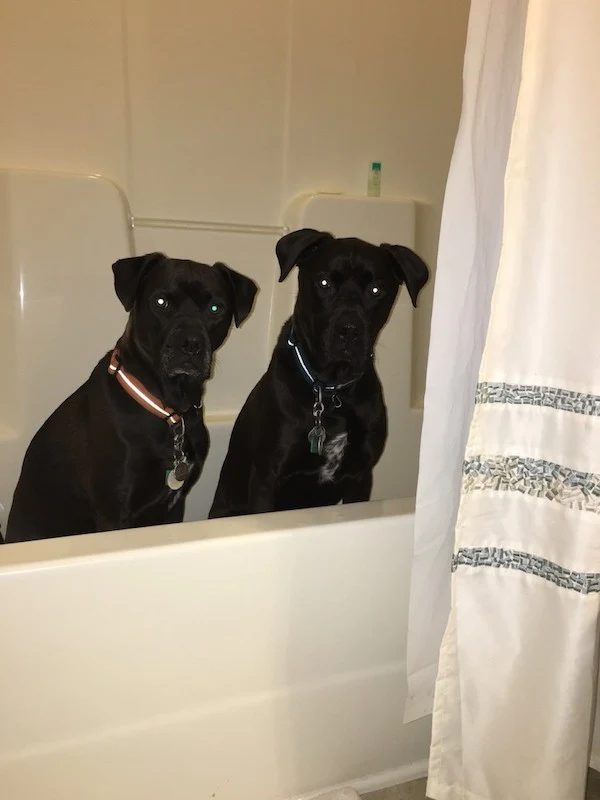
Bathe your puppy with a hose or in a kiddie pool
Another option is to bathe your puppy outside with a hose or in a kiddie pool, but of course this is only going to be feasible during the warmer months. After all, puppies get cold quickly and who wants to handle a wet puppy outside during the colder months?!
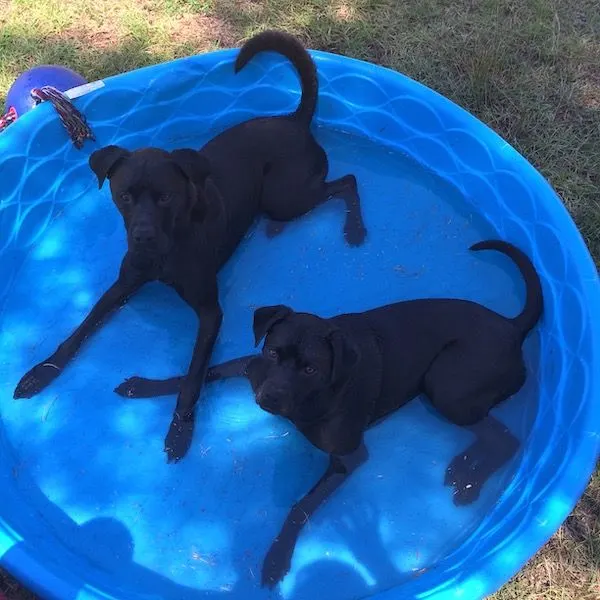
What products do I need to bathe my puppy?
The most important piece of information I can give you here is that you shouldn’t use human shampoos, showering gels, or dishwashing detergents on your puppy. That’s because they’re way too harsh and will strip your pup’s sensitive skin and coat of its natural oils.
Use a shampoo specifically for dogs
There are a plethora of specific puppy bathing products, including countless puppy and dog shampoos. I personally look for a shampoo that is not made in China does not contain a bunch of unnecessary chemicals.
Examples of dog shampoos I recommend:
- Wondercide’s Shampoo Bar for Dogs and Cats
- Anicura’s Natural Dog Shampoo
- Dr. Harvey’s Herbal Shampoo
Use a dog brush
It’s a good idea to brush your puppy before giving him a bath, ideally outside or in an area that’s easily cleanable. It’ll get rid of loose hair, which means your sink or tub drain won’t clog as much. It’s still a good idea to put some sort of drain hair catcher in there prior to your puppy’s bath.
The type of brush you’ll need depends on your puppy’s hair length and type of coat. If it’s a short wash ‘n go coat, all you need is a pet grooming glove and maybe a bristle brush. The grooming glove is a 5 finger glove with silicone grooming tips that collect loose hair on your pup all while massaging their skin.
- A Furminator brush is the best type of brush for removing the loose undercoat on most dog and cat breeds.
- Bristle brushes are a great option for general grooming of short and medium length dog hair, removing debris, and leaving a healthy shine on your puppy’s coat.
- A slicker brush will work better for long-haired puppies and dogs because it prevents mats and tangles, and also removes loose hair.
Lick pad and/or treats
Most puppies are food and treat motivated as long as you give them the really good and potentially smelly stuff! Try using either a lick pad or treats during bath time, and your puppy should be plenty busy getting to the goodies while you lather him up and hose him down.
Lick pads are actually the easier option when you don’t have any human help during puppy bath time. All you need to do is cover it in peanut butter and stick the pad up on the wall where your pup can reach it.
Treats are a great option when someone else can hand them out. Otherwise you’ll have to keep drying your hands off or at least rinse the soap off your hands before you give your puppy a treat. We recommend using pieces of cheese or real meat. We also like the brand Zuke’s minis.
Dog attachment shower head
If you bathe your pup in an actual tub, you’ll want to invest in a handheld shower head. It’ll make bath time a breeze since you’ll be able to easily reach under your puppy’s belly, tail, and both his sides. You can either use the kind you’d use yourself, or a specialized dog kind.
For example:
You can also get a hose sprayer attachment for your sink, but unless you bathe your pup(py) in a deep sink like your laundry room sink, it’s going to be most helpful for use in a bath tub.
Anti-slip shower mat
Think about lining your tub or sink with an anti-slip shower mat so your puppy doesn’t lose traction and slide all over the place.
Towels for your puppy
Extra absorbing towels should definitely make it on your list of puppy bath essentials!
There are microfiber towels made specifically for doggie bath time. They’re extra absorbing.
However, you can also get them less expensively, for example, at Walmart. The ones I got for my puppies Missy and Buzz were cheap, but thick regular towels from Walmart. Over the years, I’ve also downgraded some of my own old towels and turned them into doggie towels.
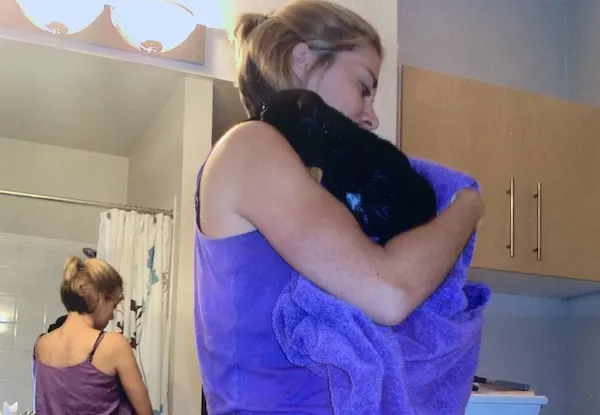
Hair dryer
Hair dryers are a good option during the colder months and work particularly well for puppies and dogs with longer coats. You can either use your own handheld regular hair dryer, or invest in a professional dog blow dryer.
The latter will cut your drying time in half, so it may be a good option for dogs with extra long coats and/or double layer coats.
When you first get your puppy used to a drier, I recommend you simply let your puppy sniff the drier while it is off and give some treats. If that goes well, try turning the drier on while your puppy is in another room chewing on a Kong or bully stick. Next, try turning it on while your puppy is near by and give treats. Only use it for a few seconds.
When using a drier, watch out for the temperature because high heat can hurt your puppy’s skin. Also don’t hold the dryer nozzle directly onto your puppy’s skin in order to avoid burning.
What time of the day is best for my puppy’s bath?
Unless it’s super urgent and you need to get poop off right away, it’s best to pick a time of day when your puppy is sleepy! That’ll make bath time easier because sleepy puppies are calm(er!) and less likely to put up a wiggle fight!
Your puppy will be most active in the mornings since he just had a good night’s sleep, so that time won’t be ideal for a bath. Instead, try a midday or evening bath when your puppy’s already had some physical exercise like short walks and playtime, and maybe even some mental input from socialization and short training sessions.
That being said, some puppies are extra wild in the evenings when they are overly tired, and some are extra excited and wild right after a walk! You know your puppy best.
It’s OK to keep your puppy on a leash during bath time if it’s easier. You’ll want to use a nylon leash rather than a leather leash for this purpose. There are even waterproof leashes that can super easily be wiped off. For example, Mighty Paw’s 6′ waterproof leash.
Things to be aware of during puppy bath time
You’ll want to keep bath time short and positive, that’s why I recommend to stop early and end on a positive note. Praise your little puppy for being such a good boywhen you’re done, and reward with some tasty treats. To keep it simple, don’t even use shampoo the first few times, unless it’s really necessary.
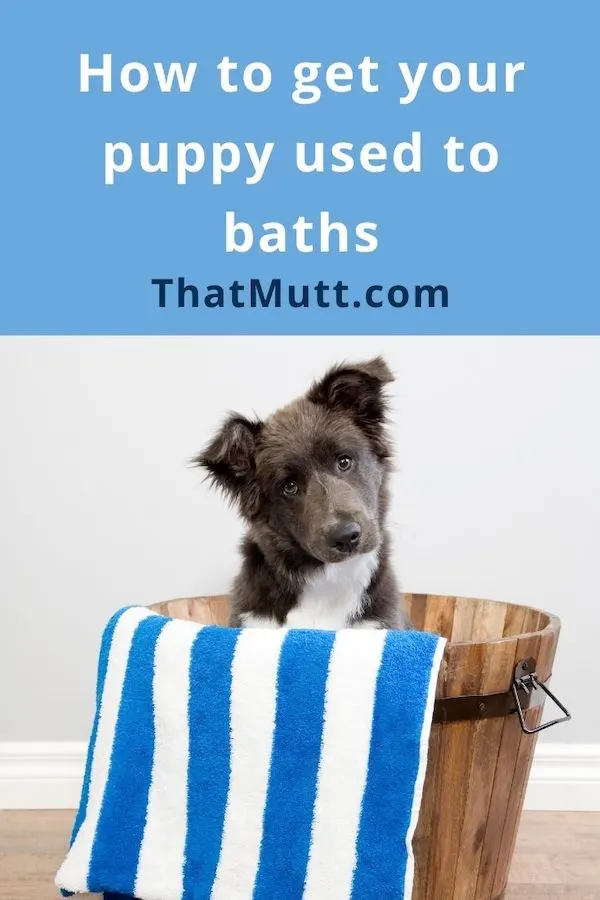
Water temperature
When it comes to setting your water temperature, you’ll want to use warm or lukewarm water rather than hot or cold water.
Puppy ears
Make sure to thoroughly wet your puppy’s coat, but don’t get any water in his ears. It’s probably going to happen at some point, which is not the end of the world either. But if you do get water in there, make sure to dry them well, especially if they’re naturally floppy. Extra moisture in your puppy’s ears can cause ear infections that are painful for your pup and expensive for you to treat.
For that reason, I always avoided taking the shower head directly to my puppies’ faces. Instead, I used a wet wash cloth.
Puppy paws
When you do use shampoo, massage it into your puppy’s coat and let it sit for a few minutes. While it’s sitting, splash a little water onto the coat to keep your puppy warm. It’s best to leave the water running if it takes a while to get the temperature right. Now is also a good time to massage your puppy’s paw pads.
This is a super important body socialization exercise! It teaches your puppy that it’s OK to have his or her paws handled. This is something many adult dogs dislike if they weren’t properly introduced to that concept as a puppy.
Rinse and dry well
Rinse their coat very well until you don’t see any soapy water. That’s because you don’t want your puppy to accidentally ingest any leftover soap when he happens to lick his coat. Last but not least, dry your puppy well with towels and/or a hair dryer, especially during the colder months.
Tip: Most puppies need to pee and/or poop right after bath time! Be prepared to let them out right away! You may want to keep them leashed for their potty break because most pups also feel the need to roll around on whatever they can find after bath time! You wouldn’t want them to roll around in a pile of mud or dust right after their bath, right?!
Most puppies are really wild after their bath!
Your puppy will probably be really excited after his bath! They typically try to run around and roll on the ground. Expect to see some serious puppy “zoomies”!
How often should you bathe your puppy?
Puppies don’t need super frequent baths because too many baths will strip their coat of its natural oils and cause dry, uncomfortable skin. Once every 4-6 weeks is completely sufficient. Many puppies wont even need a bath that often, but it’s a good idea to give a short, quick bath anyway to keep them used to it.
That said, if your puppy gets muddy or into different types of dirt, you’ll want to at least rinse him off in between baths.
What about fleas?
Healthy puppies who grew up in a clean environment are highly unlikely to have fleas when you pick them up and bring them home. So you don’t necessarily need to give your puppy a bath the day you bring him home. The breeder or shelter may have already done so, in some cases.
However, if you found your puppy in a ditch or if you adopted her from a place with unsanitary conditions, you’ll probably want to give her a preventative bath. And you might in fact find some fleas on your puppy.
If you do spot fleas, I recommend using an anti-flea shampoo that kills and repels fleas such as Wondercide’s Natural Flea and Tick Shampoo Bar for Dogs & Cats.
For general flea prevention, it’s important to know it’s best not to use most flea or other pest control products on your pup until they’re at least 8 weeks old. Ask a vet if you’re not entirely sure.
Once your puppy is 8 weeks old, you have the choice between several products such as:
- Puppy flea collars
- Topical prevention like Advantix
- Oral pills like Nexgard
- Chewable flea and tick treats
- Natural options like Wondercide’s Spray
I personally prefer the more natural options that don’t contain a lot of harsh chemicals.
Tip: Always read the respective instructions and make sure to chose the right kind for your puppy’s weight and age! Ask your vet if you have questions.
Take your puppy to the (mobile) groomer early on
Even if you don’t necessarily NEED a professional to bathe your puppy, it’s still a good idea to schedule at least a few baths here and there at a groomer’s physical or mobile salon. Consider it part of your puppy’s socialization program!
That way, your puppy gets introduced to someone else handling their body including paws, ears, and possibly even teeth if you decide to add teeth brushing to your appointment.
Trust me, it will make your life so much easier later on down the road. For example, he won’t mind getting his body and teeth checked out during vet exams, and he also won’t mind your dog walker or friend wiping down his paws after a rainy, muddy walk.
What to expect from a professional groomer
It’s up to your personal preference and budget when it comes to your puppy’s grooming visit. For starters, it’s probably sufficient to book the basics like a bath, ear cleaning and a nail trim.
Of course you can add other services like:
- brushing
- trimming/shaving
- deshedding
- anal gland expression
- teeth brushing
However, these services do add up, and it’s more expensive to have larger and long-haired puppies and dogs groomed than those with shorter coats.
Tip: Read the reviews of individual groomers before you schedule a grooming appointment for your puppy. Don’t hesitate to check the salon out in person beforehand. What you don’t want is an insanely loud and dirty place that smells. Instead, look for a reasonably quiet place that’s well ventilated and has clean grooming stations. It’s also perfectly acceptable to ask the groomer to bathe your pup with your own shampoo. I’ve done that multiple times.
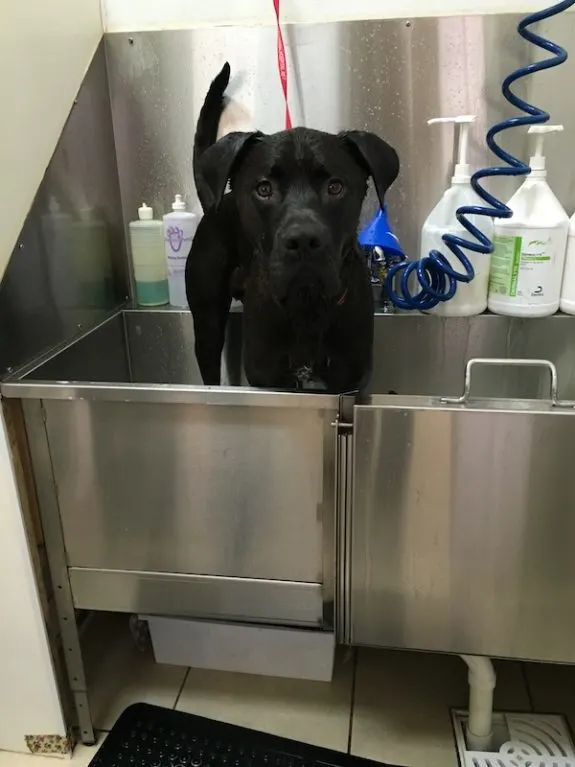
Do you have any questions about bathing your puppy?
Let us know in the comment section below.
If you’re struggling, don’t hesitate to hire a trainer for help. Even one session with a trainer can make a big difference.
*If you would like to receive our down-to-earth, weekly dog training tips, Click Here
Barbara Rivers writes regularly for That Mutt. She is a blogger, raw feeder and dog walker and maintains the blog K9s Over Coffee.
Related posts:
- Easy Socialization Tips for Dogs and Puppies
- Is It Safe To Put Flea Prevention On A Puppy?
- How to Get My Dog Used to Nail Trims
- My Dog is Aggressive at the Vet

Janet Fazio
Monday 9th of November 2020
I use the shower too as my dog is too heavy to get in the tub and she will NOT get in there herself. I "lock" the door using a spatula so she can't get out, but I will try a lick pad. Seems like it will be less traumatic for both of us!
Aisling
Wednesday 4th of November 2020
I dont have a bath in my house so have to wash the dog in the shower. My old collie to jump out at every opportunity! I think I got more wet than the dog! :)
Lana
Thursday 3rd of December 2020
Hahaha, same! I got into the shower with my dog once and closed the door in case she won't jump out. Bad idea :D
Lindsay Stordahl
Wednesday 4th of November 2020
Haha, I can imagine!